Testicular torsion
Testicular torsion is twisting of the spermatic cord, which supports the testes in the scrotum. When this occurs, blood supply is cut off to the testicles and nearby tissue in the scrotum. This may cause permanent damage to the testicle.
Scrotum
The scrotum is a part of a male's body that is located below the penis. The scrotum is the sac (pouch) that contains the testes, epididymis, and the...

Causes
Some men are more prone to this condition because of defects in the connective tissue within the scrotum. The problem may also occur after an injury to the scrotum that results in a lot of swelling, or following heavy exercise. In some cases, there is no clear cause.
The condition is more common during the first year of life and at the beginning of adolescence (puberty). However, it may happen in older men.
Symptoms
Symptoms include:
- Sudden severe pain in one testicle. The pain may occur without a clear reason.
- Swelling within one side of the scrotum (scrotal swelling).
Scrotal swelling
Scrotal swelling is abnormal enlargement of the scrotum. This is the name for the sac surrounding the testicles.
 ImageRead Article Now Book Mark Article
ImageRead Article Now Book Mark Article - Nausea or vomiting.
Additional symptoms that may be associated with this disease:
- Testicle lump
Testicle lump
A testicle lump is swelling or a growth (mass) in one or both testicles.
 ImageRead Article Now Book Mark Article
ImageRead Article Now Book Mark Article - Blood in the semen
Blood in the semen
Blood in the semen is called hematospermia. It may be in amounts too small to be seen except with a microscope, or it may be visible in the ejaculat...
 ImageRead Article Now Book Mark Article
ImageRead Article Now Book Mark Article - Testicle pulled to a higher position in scrotum than normal (high riding)
Exams and Tests
Your health care provider will examine you. The exam may show:
- Extreme tenderness and swelling in the testicle area.
- The testicle on the affected side is higher.
You may have a Doppler ultrasound of the testicle to check the blood flow. There will be no blood flowing through the area if you have complete torsion. Blood flow may be reduced if the spermatic cord is partly twisted.
Treatment
Most of the time, surgery is needed to correct the problem. The procedure involves untwisting the cord and sewing the testicle to the inside wall of the scrotum. Surgery should be done as soon as possible after symptoms begin. If it is performed within 6 hours, most of the testicle can be saved.
During surgery, the testicle on the other side is often secured into place as well. This is because the unaffected testicle is at risk of testicular torsion in the future.
Outlook (Prognosis)
The testicle may continue to function properly if the condition is found early and treated right away. The chances that the testicle will need to be removed increase if blood flow is reduced for more than 6 hours. However, sometimes it may lose its ability to function even if torsion has lasted fewer than 6 hours.
Possible Complications
The testicle may shrink if blood supply is cut off for an extended time. It may need to be surgically removed. Shrinkage of the testicle may occur days to months after the torsion has been corrected. Severe infection of the testicle and scrotum is also possible if the blood flow is limited for a long period.
When to Contact a Medical Professional
Get emergency medical attention if you have symptoms of testicular torsion as soon as possible. It is better to go to an emergency room instead of an urgent care in case you need to have surgery right away.
Prevention
Take steps to avoid injury to the scrotum. Many cases cannot be prevented.
Reviewed By
Kelly L. Stratton, MD, FACS, Associate Professor, Department of Urology, University of Oklahoma Health Sciences Center, Oklahoma City, OK. Also reviewed by David C. Dugdale, MD, Medical Director, Brenda Conaway, Editorial Director, and the A.D.A.M. Editorial team.
Elder JS. Disorders and anomalies of the scrotal contents. In: Kliegman RM, St. Geme JW, Blum NJ, Shah SS, Tasker RC, Wilson KM, eds. Nelson Textbook of Pediatrics. 21st ed. Philadelphia, PA: Elsevier; 2020:chap 560.
Germann CA. Urologic disorders. In: Walls RM, ed. Rosen's Emergency Medicine: Concepts and Clinical Practice. 10th ed. Philadelphia, PA: Elsevier; 2023:chap 89.
Kryger JV, Jarosz SL. Acute and chronic scrotal swelling. In: Kleigman RM, Toth H, Bordini BJ, Basel D, eds. Nelson Pediatric Symptom-Based Diagnosis. 2nd ed. Philadelphia, PA: Elsevier; 2023:chap 24.
Palmer LS, Palmer JS. Management of abnormalities of the external genitalia in boys. In: Partin AW, Domochowski RR, Kavoussi LR, Peters CA, eds. Campbell-Walsh-Wein Urology. 12th ed. Philadelphia, PA: Elsevier; 2021:chap 44.
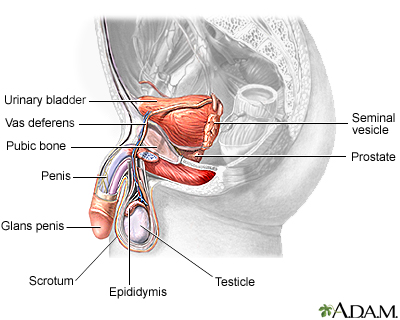
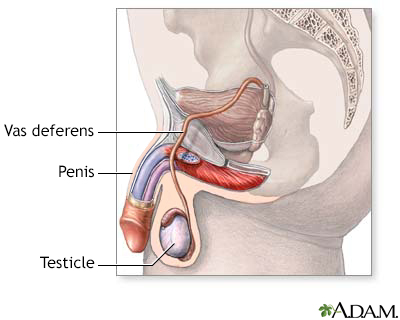
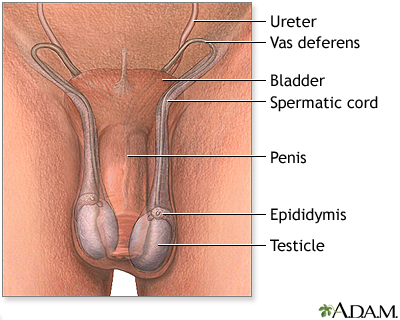

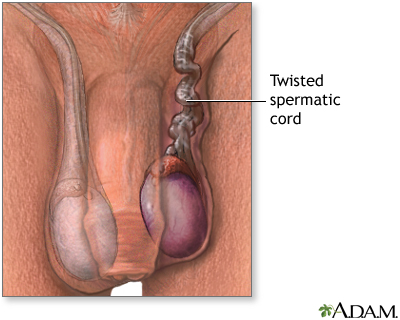
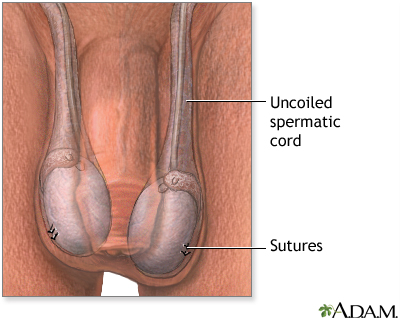
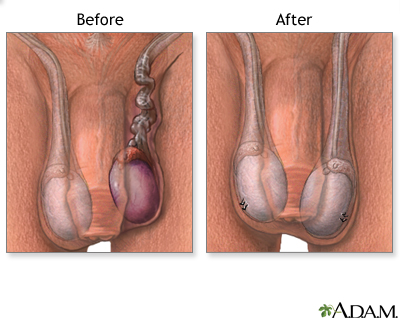
 All rights reserved.
All rights reserved.